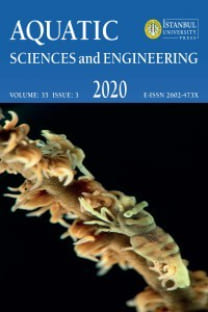Evaluation of different scale-up strategies for Haematococcus pluvialis cultivation in airlift photobioreactor
Large scale algal biomass production can be very challenging due to the potential issues of sustain-ability, environmental ethics, and economic concerns. A strategic approach to the transition from the laboratory to the industrial scale allows the prediction of process characteristics, design and analysis of large scale systems, and reduction of extra costs. In this study, a scale-up procedure that consid-ered different approaches was carried out by selecting the Haematococcus pluvialis as a model or-ganism. Three scale-up parameters (constant mixing time (tm), volumetric power consumption rate (P/V), and oxygen mass transfer coefficient (kLa)) were tested for biomass production in a 2-L airlift photobioreactor and they were compared with those obtained from a 1-L aerated cultivation bottle. Among three strategies, the maximum cell concentration, 4.60±0.20×105 cells/mL, was obtained in a constant volumetric power consumption rate experiment. Also, total carotenoid amount showed similar changes with the cell concentration and reached the maximum concentration of 2.02±0.11 mg/L under constant P/V experiment. However, the cultivation bottle presented the highest biomass amount of 0.62 g/L and specific growth rate of 0.38 day-1 of all of the photobioreactors. This result might be attributed to the low aeration rates or improper configuration of the system, which created a non-homogenous culture medium and led to ineffective mass transfer.
Keywords:
Haematococcus pluvialis Scale-up, Airlift photobioreactor, Biomass production, Carotenoid,
___
- Aslanbay Guler, B., Deniz, I., Demirel, Z. & Imamoglu, E. (2020). Evaluation of scale-up methodologies and computational fluid dynamics simulation for fucoxanthin production in airlift photobioreactor. Asia-Pacific Journal of Chemical Engineering, 15:e2532. [CrossRef] google scholar
- Aslanbay Guler, B., Deniz, I., Demirel, Z., Oncel, S. S. & Imamoglu, E. (2019). Transition from start-up to scale-up for fucoxanthin production in flat plate photobioreactor. Journal of Applied Phycology, 31:1525-1533. [CrossRef] google scholar
- Azhand, N., Sadeghizadeh, A. & Rahimi, R. (2020). Effect of superficial gas velocity on CO2 capture from air by Chlorella vulgaris microalgae in an Airlift photobioreactor with external sparger. Journal of Environmental Chemical Engineering, 8, 1040222. [CrossRef] google scholar
- Bailey, J. E. & Ollis, D. F. (1986). Biochemical engineering fundamentals. New York: McGraw-Hill Chemical Engineering Series, 984. google scholar
- Bendetti, M., Vecchi, V., Barera, S. & Dall’Osto, L. (2018). Biomass from microalgae: the potential of domestication towards sustainable biofactories. Microbial Cell Factories, 17, 173. [CrossRef] google scholar
- Chisti, Y. & Jauregui-Haza, U. J. (2002). Oxygen transfer and mixing in mechanically agitated airlift bioreactors. Biochemical Engineering Journal, 10(2), 143-153. [CrossRef] google scholar
- Choi, Y. Y., Hong, M. E., Jin, E. S., Woo, H. M. & Sim, S. J. (2018). Improvement in modular scalability of polymeric thin-film photobioreactor for autotrophic culturing of Haematococcus pluvialis using industrial flue gas. Bioresource Technology, 249, 519526. [CrossRef] google scholar
- Deniz, I. (2020). Scaling-up of Haematococcus pluvialis production in stirred tank photobioreactor. Bioresource Technology, 310, 123434. [CrossRef] google scholar
- Ding, N., Li, C., Wang, T., Guo, M., Mohsin A. & Zhang, S. (2021). Evaluation of an enclosed air-lift photobioreactor (ALPBR) for biomass and lipid biosynthesis of microalgal cells grown under fluid-induced shear stress, Biotechnology & Biotechnological Equipment, 35(1):139-149. [CrossRef] google scholar
- Haque, F., Dutta, A., Thimmanagari, M. & Chiang, Y. W. (2017). Integrated Haematococcus pluvialis biomass production and nutrient removal using bioethanol plant waste effluent. Process Safety and Environmental Protection, 111, 128-137. [CrossRef] google scholar
- Mazumdar, N., Novis, P. M., Visnovsky, G. & Gostomski, P. (2019). Effect of culturing parameters on the vegetative growth of Haematococcus alpinus (strain lcr-cc-261f) and modeling of its growth kinetics. Journal of Phycology, 55(5), 1071-1081. [CrossRef] google scholar
- Ranjbar, R., Inoue, R., Katsuda, T., Yamaji, H. & Katoh, S. (2008). High Efficiency Production of Astaxanthin in an Airlift Photobioreactor. Journal of Bioscience and Bioengineering, 106(2), 204-207. [CrossRef] google scholar
- Rippka, R., Deruelles, J., Waterbury, J. B., Herdman, M. & Stanier, R. Y. (1979). Generic assignments, strain histories and properties of pure cultures of cyanobacteria. Microbiology, 111, 1-61. [CrossRef] google scholar
- Shah, M. M. R., Liang, Y., Cheng, J. J. & Daroch, M. (2016). Astaxanthin-Producing Green Microalga Haematococcus pluvialis: From Single Cell to High Value Commercial Products. Frontiers in Plant Science, 7, 531. [CrossRef] google scholar
- Shuler, M. L. & Kargi, F. (2002). Bioprocess engineering: Basic concepts. NJ: Prentice Hall. google scholar
- Van’t Riet, K. & Tramper, J. (1991). Basic bioreactor design. New York: Marcel Dekker. [CrossRef] google scholar
- Vega-Estrada, J., Montes-Horcasitas, M. C., Dominguez-Bocanegra, A. R. & Canizares-Villanueva, R. O. (2005). Haematococcus pluvialis cultivation in split-cylinder internal-loop airlift photobioreactor under aeration conditions avoiding cell damage. Biotechnological Products and Process Engineering, 68, 31-35. [CrossRef] google scholar
- Wang, H., Zhang, W., Chen, L., Wang, J. & Liu, T. (2013). The contamination and control of biological pollutants in mass cultivation of microalgae. Bioresource Technology, 128, 745-750. [CrossRef] google scholar
- Wellburn, A. R. (1994). The spectral determination of chlorophylls a and b, as well as total carotenoids, using various solvents with spectrophotometers of different resolution. Journal of Plant Physiology, 144, 307-313. [CrossRef] google scholar
- Zhu, J., Chen, W., Chen, H., Zhang, X., He, C., Rong, J., Wang, Q. (2016). Improved Productivity of Neutral Lipids in Chlorella sp. A2 by Minimal Nitrogen Supply. Frontiers in Microbiology, 7, 557. [CrossRef] google scholar
- Yayın Aralığı: Yılda 4 Sayı
- Başlangıç: 1987
- Yayıncı: İstanbul Üniversitesi
Sayıdaki Diğer Makaleler
Latife KÖKER, Ayça OĞUZ ÇAM, Reyhan AKÇAALAN, Meriç ALBAY
Selda ÖZTÜRK, Sevil SUNGUR, Burak SEÇER, Erdoğan ÇİÇEK
Eyüp ÇAKMAK, Şirin FİRİDİN, Nilgün AKSUNGUR, Yahya ÇAVDAR, İlker Zeki KURTOĞLU, Muharrem AKSUNGUR, Osman Tolga ÖZEL, Ekrem Cem ÇANKIRILIGİ, Zehra Duygu DÜZGÜNEŞ, Esin BATIR
Bahar ASLANBAY GÜLER, İrem DENİZ, Zeliha DEMİREL, Esra İMAMOĞLU
Md. Abu Hena Mostofa KAMAL, Md. Abu KAWSAR, Debasish PANDİT, Mrityunjoy KUNDA, Khushnud TABASSUM, Md. Tariqul ALAM
Emine Gözde ÖZBAYRAM, Derya ÇAMUR, Latife KÖKER, Ayça OĞUZ ÇAM, Reyhan AKÇAALAN, Meriç ALBAY
